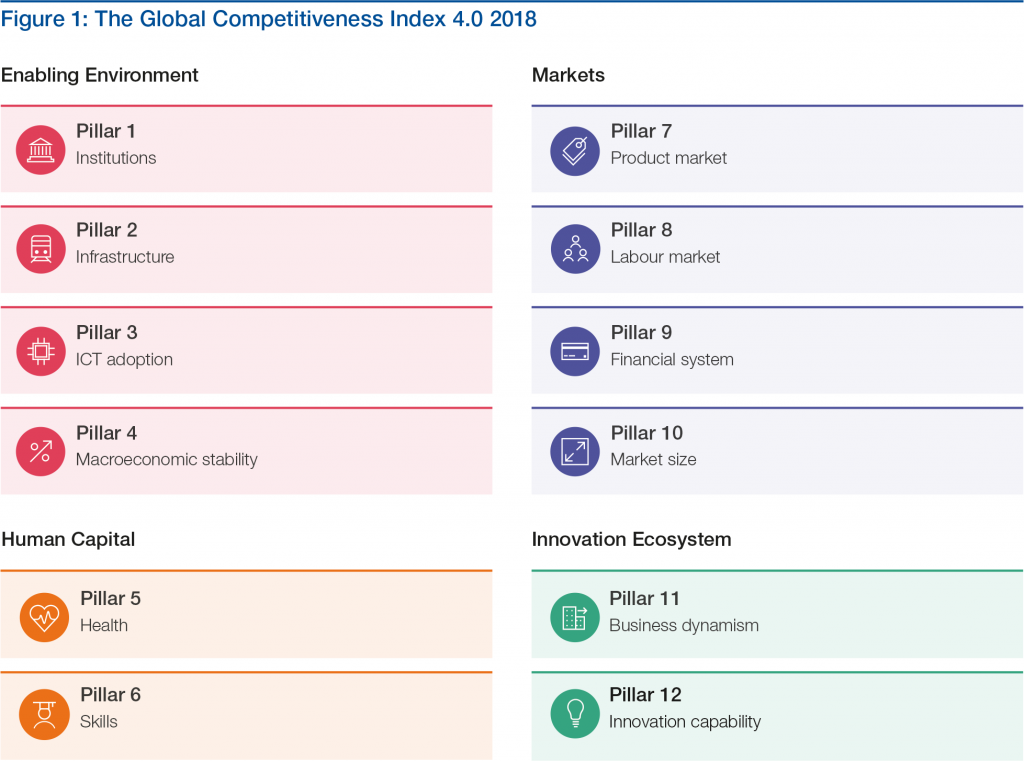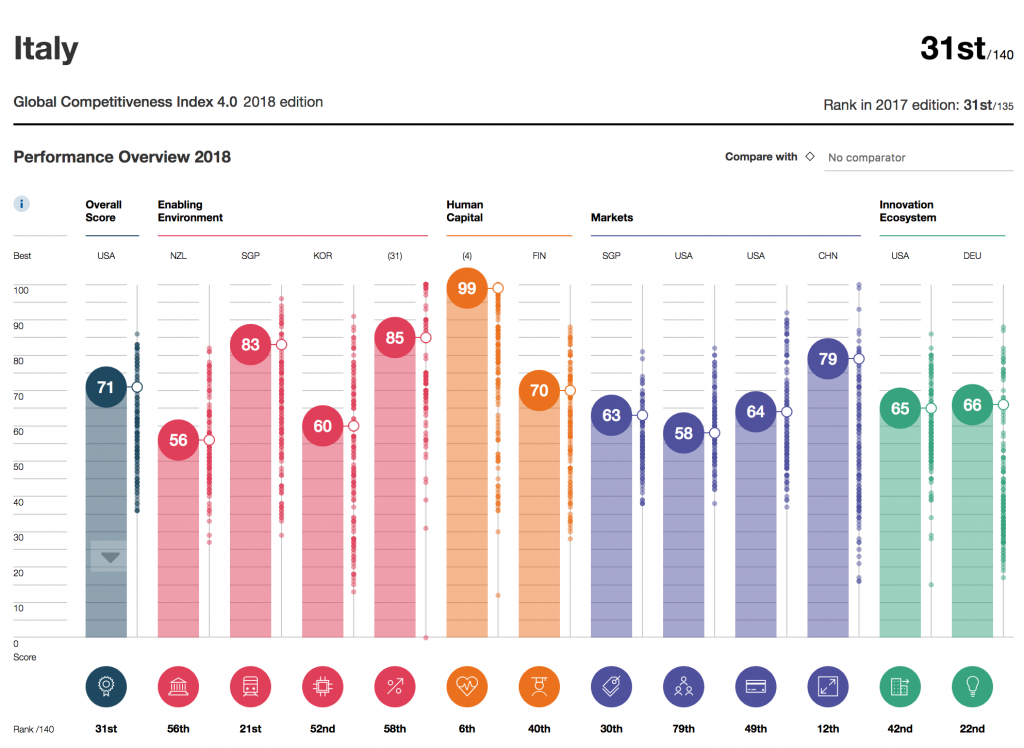Italy is not “future-proof”
27 November 2018 | Written by Cristina Pozzi
The last report of the World Economic Forum is clear: in Italy there are still difficulties about knowing how to face the future. But what can we do to make Italy, once and for all, future-proof?

Our legislative system is not ready for the future and risks blocking the possibility for Italy to face the fourth industrial revolution as a protagonist. In the ranking published every year by the WEF (http://reports.weforum.org/global-competitiveness-report-2018/) which analyzes the ability of a country system to be competitive in an increasingly technological, innovative and fast-paced world, Italy has excellent parameters; however, a parameter, in which our position is among the worst in the world, stands out: the ability of the government to face the future.
“Italy”, emphasizes the study, “is in 31st place overall and 17th place in Europe. The country’s GDP grows by 1.5%, the fastest rate since the 2008 financial crisis. Yet, the advanced economy is still growing slower. To improve its prosperity, Italy should focus on its competitiveness and growth program, building on its strengths and addressing its weaknesses.”
The Global Competitiveness Report
Since 2015 the Global Competitiveness Report of the World Economic Forum analyzes a country’s ability to cope with the challenges of the fourth industrial revolution.
The index considers, in particular, four fundamental factors to be future proof:
- Resilience
- Agility, propensity for change
- Construction of an innovation ecosystem
- Adoption of a human-centric approach to economic development.
The four factors then develop on twelve fundamental pillars. For example, resilience is evoked by the pillar of the financial system while the concept of agility is linked to competition on the national market and entrepreneurial culture.

You can learn more about the methodology here.
Italian system’s position
It is important to underline that, in general, compared to the report of the previous period, the Italian ranking remained unchanged or slightly improved in almost all the parameters.
This is the overall image of the Italian result in the various areas of interest.

In some cases, our country represents a real excellence, for example in the health parameter, where it is well positioned at the sixth place globally, or in infrastructures and in the ability to innovate, where it is respectively twenty-first and twenty-second, or, again, in the market size, twelfth for global ranking. In the evaluation of the educational sector we certainly do not excel, but we are not even among the worst either, positioning ourselves at the places between the fiftieth and fortieth of the rankings linked to the present and future availability of the skills necessary for the job.
The points that the study identifies as “to be improved” are the adoption of ICT, the private sector that should be more open to new business models and disruptive ideas, and the need for a more positive risk-taking attitude. But the real criticality lies in the fact that, without a modernization of the financial system and of the public administration, there is a lack resources for innovative investments and the bureaucracy risks suffocating economic activity.
Analyzing the report, it is clear, in particular, that our Achilles’ heel could lurk in the legislative machine and risks, to tend, to be the ruin of the whole system: in fact, the Legislator’s ability to keep up with the time and with the changes in progress and therefore enable the innovation that is present in the various actors of the system.
Warning: we are not saying that we are below average but that, according to the index, in this parameter Italy is among the worst in the world.
Our Achilles’ heel
Let’s try to investigate what the concept of being in step with the times means for the report.
This is found within the pillar linked to the institutions where, overall, Italy is in fifty-sixth place in one hundred and forty countries analyzed. In turn this pillar is divided into various sub-indices where the Future orientation of the government stands out. It is precisely here that the bad news arrives: to find Italy, in fact, we have to go down to the one hundred and twenty-fifth position of one hundred and forty. This sub-index is in turn composed of:
Ranking Score
– a government guaranteeing legislative stability 127/140 2.8/7
– the ability to respond to change by the government 122/140 2.5/7
– the ability to adapt the legislative framework to the new digital business models 101/140 3.2/7
– the long-term vision capability 130/140 2.2/7
In these parameters excel Singapore, USA and countries like United Arab Emirates, Saudi Arabia.
It should be noted that this part of the index is created on the basis of a questionnaire that received just over 12,000 responses worldwide that was submitted to a top executive target. In particular, the Italian index is based on 89 replies received to the following questions:
- In your country, how fast is the legal structure in adapting to digital business models (eg, E-commerce, sharing economy, fintech, etc.)? [1 = not fast at all; 7 = very fast];
- In your country, to what extent does the government guarantee a stable political environment for the business?
- In your country, to what extent does the government respond effectively to changes (for example, technological change, social and demographic trends, security and economic challenges)?
- In your country, to what extent does the government have a long-term vision? For the last three questions, the answer ranges from 1 [not at all] to 7 [to a large extent].
The perception of respondents to the questionnaire was therefore drawn, and not an objective quantitative index, just as no questions were asked directly to the Legislator.
What is Future Orientation
Perhaps, when we talk about the future, it may not be so important to trace any discrepancies between perception and reality. In fact, the future has the capacity to self-realize: what we imagine often becomes what we create, and the reason is contained precisely in the role that the image of the future plays in our psychology. If the Legislature is perceived as not future-oriented, the whole system will behave accordingly.
But why is it important to measure Future Orientation and what does it mean?
Let’s try starting from the definitions. If we talk about Future Orientation, we are talking about what in the literature of studies on the future is called Future Consciousness. Anita Rubin, a scholar of this field, has defined this concept as “an active and action-oriented perspective on the future, present and past and the relations between them. [It is] an internalized form of the development of thought [and] a specific effort to form a conception of the meanings and consequences of the problems and our daily actions”.
The scholar then highlights an active perspective that considers all the dimensions of time and in which our daily actions find its roots.
Sharpe & Hodgson have developed this concept by defining three possible attitudes that are described through as many profiles:
- a managerial approach that takes into account a short-term vision,
- an entrepreneurial approach that considers a medium-term vision,
- and finally a visionary approach that takes into account instead of a long-term vision.
All three approaches have their usefulness and, according to the authors, they should be used in harmony to create a more complete and effective future conscience in what they have called Three horizons methodology.
The Future Orientation is therefore one of the fundamental aspects of the Future Conscience and is often dealt with in an interdisciplinary way between psychology and future studies. In this context, the Future Orientation would be precisely the aspect in which it is able to highlight an expected future as a motivating factor for the action of the individual, or, in the case of a government, of the community. A strategic dimension that becomes fundamental in the ability to make decisions (Trommsdorff, 1983).
Why is it important?
Frederik Polak in 1971 highlighted how the ability to think about the future in a structured way and that of increasing the future conscience on a collective level was one of the keys to overcoming a moment of widespread pessimism in spite of rapid technological development in Europe after the II World War. It is evident that there are many similarities with the current social and cultural crisis, and that, if Polak was right, we are faced with the answer to one of the great problems of our time.
In fact, in the last thirty years some studies have shown how the ability to imagine oneself, as individuals or as a society, in many different evolutions (possible, probable or preferable) allows to improve the planning, the achievement of results and the improvement the ability to face risks and be resilient. All these characteristics are useful both at a personal level and, above all, at the level of government. This is why future orientation is a key factor to be measured and nurtured.
Increasing the future consciousness at all levels in our society is a priority if we want our country to be able not only to be part of the ongoing global revolution, but to influence it in a direction that has been chosen by society with awareness and responsibility.
On the one hand, therefore, the Legislator should act with strategies that take into account all the time horizons theorized by Sharpe & Hodgson also acting as an entrepreneur and visionary and not only as a manager with time counted; on the other hand the future conscience of the whole society must be spread and increased in order to give all the tools to be an active part of the change and to make the action of the government itself effective.
Impactscool, thanks to its teaching about the future and to the approach to change with both students and of all ages and adults, is, today, one of the protagonists of this process in Italy.
Acting where a great capacity for innovation is widespread, also according to the index of the World Economic Forum, it is in fact possible to give confidence (or to give it back) in the possibility of looking together with the future and innovating in Italy.
If, on the other hand, we forget the dimension of the long term, we lose the ability to act and make decisions responsibly and as a result, we also lose the ability of the entire country to innovate and improve in terms of competitive capacity.
We have so many strengths that it would be a shame to miss the opportunity to express them. This is why it is necessary to transform the country into a future-proof Italy and we can do so starting from a continuous exercise of vision and observation at all levels of society.
Articolo in italiano





